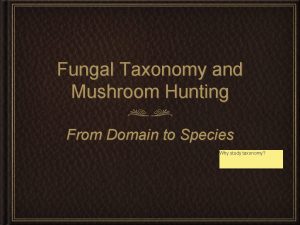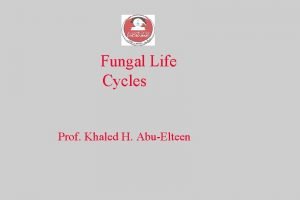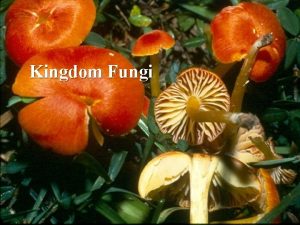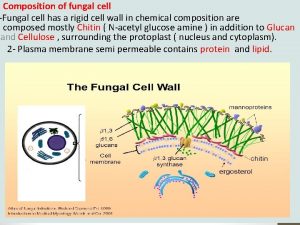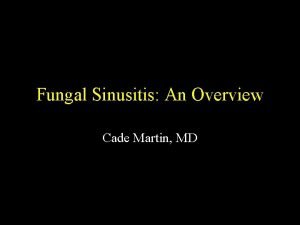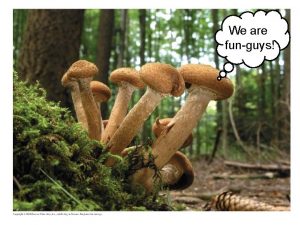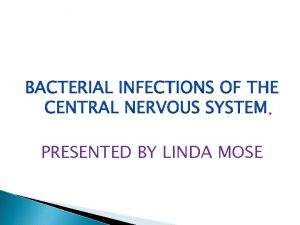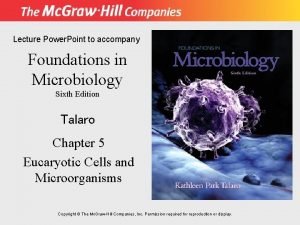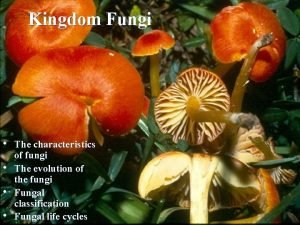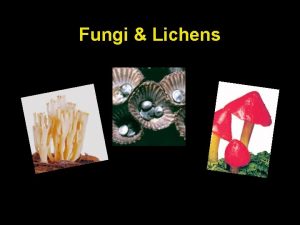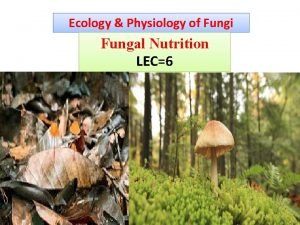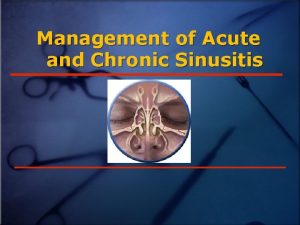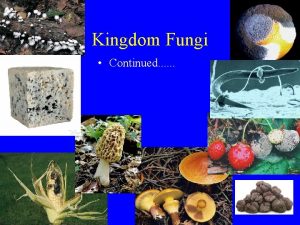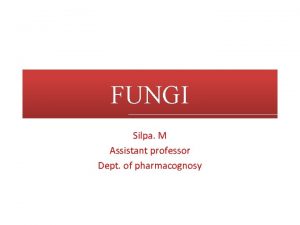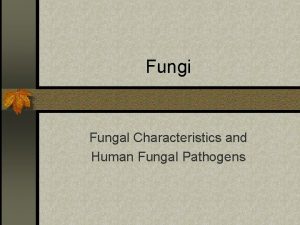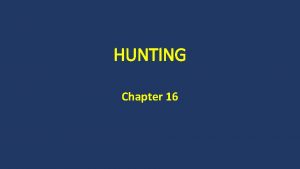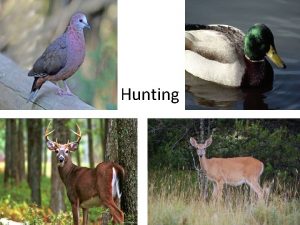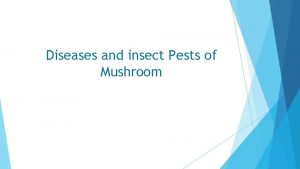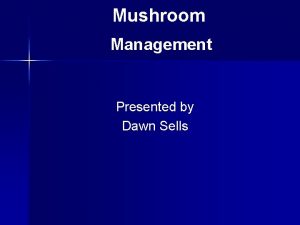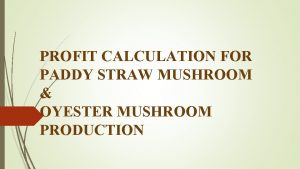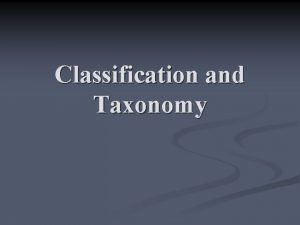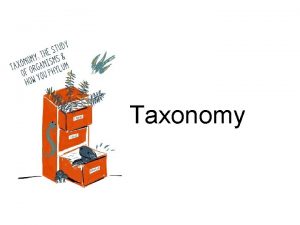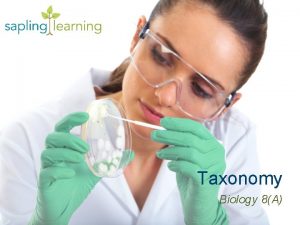Fungal Taxonomy and Mushroom Hunting From Domain to

















- Slides: 17

Fungal Taxonomy and Mushroom Hunting From Domain to Species Why study taxonomy?

Domains

Kingdoms


MAJOR TAXONOMIC GROUPINGS: Basidiomycota -- Most charismatic macrofungi; spores produced in basidia; well-developed mycelium with narrow septate mycelium. Glomeromycota -- Aka Arbuscular Mycorrhizal fungi, meaning they enter the roots of the plants; include some trufflelike species; large, multi-nucleate asexual spores Zygomycota -- Include molds; may have asexual or sexual spores; grow on dung Amanita muscaria Ascomycota -- Include other charismatic macrofungi; spores produced in asci; largest group Chytridiomycota -- Structured simply with unicells or short-branched hyphae; in aquatic and moist terrestrial habitats Deuteromycota -- Aka fungi imperfecti, include molds; not very well-studied This is all changing. . . Morchella esculenta

Division Subdivision From Kingdom to Species Class Order Family Genus Species Fungi Eumycota Basidiomycotina Hymenomycetes

Types of Hymenia Jelly Gilled Polypores Toothed Puffballs Truffles

Types of Hymenia Club, coral or fan-like Molds Rusts Cup Morels, false Morels and Elfin Saddles Crusts And more. . .

Vocabulary Anastamose - Gills or hyphae that diverge and re-converge Basal - At or near the base Cespitose - Tufted or clustered Cystidia - Microscopic specialized sterile cells projecting from the gills, tubes or stalk Entire - Gills with smooth edges, not serrated Epigeous - Growing above ground Hymenia - Spore-bearing tissue Hypogeous - Growing below ground Lamellae - Gills

Parts of a Mushroom

Descriptions of morphology Get to know the terminology of your field guide. For every mushroom you see, try to find as many ways to describe it as possible.

A Few important Families Agaricus bisporus Agaricaceae: Saprophytes with membranous stalk, gills pinkish when young and brown spores. Some stain red, some others stain yellow. Most are edible. Suillus luteus Boletaceae: Mycorrhizal, convex to Amanitaceae: flat cap, has tubes Ectomycorrhizal, cap (pores) as hymenia. may carry veil tissue, Stalks have various may either have a partial or universal veil, types of ornamentation. Varying shades of white gills and white spores. Responsible for yellow, brown or black spores. Usually squishy roughly 90% of mushroom poisonings. and maggoty but yummy. Amanita phalloides

A Few more important Families Russulaceae: Polyporaceae: Chalky stem, with a Most are Bracket brittle cap that is plane fungi with pores, but in age. The flesh some have gill-like contains large spherical structures, and some cells called have stems. Most “sphaerocysts. ” Have a have white spores. hypogeous relative, like Saprotrophic. many other epigeous Includes Trametes, fungi. Some are edible, Lenzites, some cause and Polyporus. gastrointestinal distress. Clavariaceae: Finger-like structure, the upper half of which bears spores. May be saprotrophic, mycorrizal or parasitic. Most are edible but not choice, some cause gastrointestinal distress.

Hunting Mushrooms There are estimated to be 10, 000 species of mushrooms in North America, although I would venture to guess that there are far more than that. Of those, about 250 are considered edible, and only about half of those are actually yummy. There are only a handful of species that are so poisonous that they can kill you, but a whole lot that will give you a belly ache. There also some species that are easier for some people to digest than others. Always start with a small amount.

TIPS ON HUNTING MUSHROOMS Warning: Improper identification can result in sickness, and even death. Get more than one book, find other people to work with, and always double or triple check your work. Things to look for: -substrate -recent weather -abundance -growth habit -date -location -nearby plants Supplies in the field: -Basket and/or nonplastic bag -knife. -ID book Supplies back at home: -Microscope -Hand lens -More mushroom books -Paper and bowl for making spore prints Use all of your senses, move slowly. Increase your awareness of your local ecosystem, re-connect with it and watch yourself become a part of it.

Ethical Hunting When hunting, its important to remember that each mushroom takes a lot of mycelia, sugar/energy and carbon to make, and that’s how they distribute their spores. Keep in mind that mushrooms are an important food source for many animals. Some people say only take a 1/3, or ½ of a patch. Once you get to know the fungi personally, it’ll be easier to estimate what an appropriate amount looks like.

Questions. . . ?
 Mushroom taxonomy classification
Mushroom taxonomy classification Kendall's and marzano's new taxonomy
Kendall's and marzano's new taxonomy Sac fungi life cycle
Sac fungi life cycle Fungal cell characteristics
Fungal cell characteristics Single celled fungi
Single celled fungi When performing a hand skin and nail analysis
When performing a hand skin and nail analysis Fungal uveitis
Fungal uveitis Allergic fungal sinusitis
Allergic fungal sinusitis Nail diseases and disorders milady
Nail diseases and disorders milady There fungus among us
There fungus among us Csf findings in meningitis table
Csf findings in meningitis table Fungal reproduction
Fungal reproduction Chytridiomycota examples
Chytridiomycota examples Fungus classification
Fungus classification Haustorium in fungi
Haustorium in fungi Allergic fungal sinusitis treatment
Allergic fungal sinusitis treatment Fungi
Fungi Difference between yeast and mushroom
Difference between yeast and mushroom
